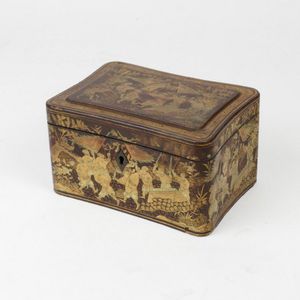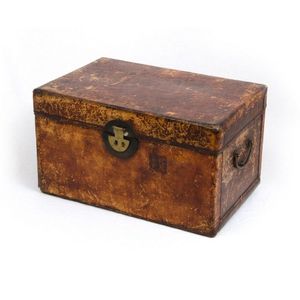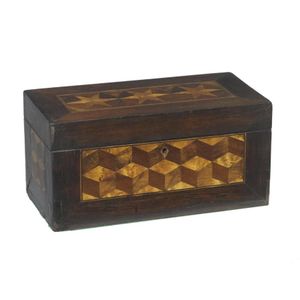Huon Pine & Rosewood Parquetry Tea Caddy, 19th Century
You must be a subscriber, and be logged in to view price and dealer details.
Subscribe Now to view actual auction price for this item
When you subscribe, you have the option of setting the currency in which to display prices to $Au, $US, $NZ or Stg.
- Huon Pine - Named after the Frenchman who discovered the Huon River in Tasmania, it is an extremely slow growing and long living tree. Huon pine is native to Tasmania, and it can grow to an age of 3,000 years or more. The wood contains oil that retards the growth of fungi, hence its early popularity in ship-building in convict-era Tasmania. The timber is a warm yellow colour, finely grained, and was popular for household furniture in the Victorian era. Interestingly, much Huon pine furniture was made in South Australia. Huon pine is a protected species and only limited quantities are available nowadays, for craftsmen to manufacture small items such as platters, sculptures and other decorative objects.
- Rosewood - A dense timber that varies in shade to very light brown to almost black. When rosewood is cut and sanded the colour of the timber will turn black, and after polishing and exposure to daylight, the surface will gradually lighten over time to light brown with black streaks.
The name comes from the odour emanating from the timber when it is planed, sanded or cut.
Rosewood was very popular for use in Victorian furniture in the second half of the 19th century, and at that time most of the rosewood was imported from Brazil. However it also grows in India and Indonesia.
It is used in the sold for chairs and table legs, but for carcase furniture such as side cabinets and bookcases, and for table tops it is always used as a veneer.
This item has been included into following indexes:
-
tea caddies, material
- huon pine 2
- rosewood 147
- specimen wood 5
Visually similar items

A carpenters tool trunk, Australian red cedar, 19th century, fitted with compartment and drawers, 51 cm high, 103 cm wide, 50 cm deep

A Victorian chinoiserie tea caddy, the interior with tin liner, the lid decorated with conforming chinoiserie designs, ivory button, width 16.5 cm, depth 11.5 cm, height 9.5 cm.

A Victorian mahogany writing slope, hinged lid with cut brass inlay and similar design to the keyhole escutcheon opening to reveal a lined and fitted interior with a secured drawer and recessed handle to the side. 50 cm x 29 cm x 20 cm

Early Chinese leather trunk. Brown polished leather, (worn surface). Brass handles & clasp. Character marks to front.
